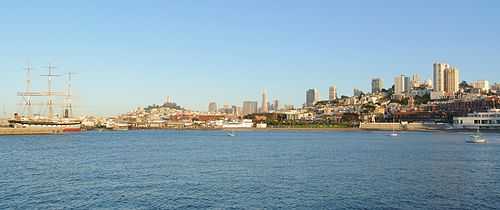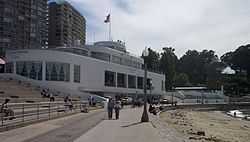Aquatic Park Historic District
| Aquatic Park Historic District | |
|---|---|
|
San Francisco Maritime Museum | |
| Location | San Francisco, California |
| Coordinates | 37°48′23″N 122°25′26″W / 37.8063°N 122.424°WCoordinates: 37°48′23″N 122°25′26″W / 37.8063°N 122.424°W |
| Architect | Works Progress Administration |
| Architectural style(s) | Moderne |
| Governing body | National Park Service |
| Designated | January 26, 1984[1] |
| Reference no. | 84001183 |
| Designated | May 28, 1987[2] |
| Official name: Entrance of the San Carlos into San Francisco Bay[3] | |
| Designated | 1936 |
| Reference no. | 236 |
 Location of Aquatic Park Historic District in San Francisco County | |
Aquatic Park Historic District is a National Historic Landmark and building complex located on the San Francisco Bay waterfront within San Francisco Maritime National Historical Park.
The district includes a beach, bathhouse, municipal pier, restrooms, concessions stand, stadia, and two speaker towers.[4]

The District's San Francisco Maritime Museum building was built as a bathhouse in 1936 by the WPA; in Streamline Moderne style, its interior is decorated with fantastic and colorful murals. The Steamship Room illustrates the evolution of maritime technology from wind to steam, and there are displays of lithographic stones, scrimshaw, and whaling guns and photo-murals of San Francisco's early waterfront. A visiting-attractions gallery hosts such exhibition as Sparks (2005), which showcased shipboard radio, radiotelephone, and radioteletype equipment from over the years.
In front of the Maritime Museum is a man-made lagoon on the site of the former Black Point Cove. To the west is the horseshoe-shaped Municipal Pier, which was voted SFWeekly 's Best Place to Go Fish 2009.[5] The lagoon is fronted by a sandy beach and a stepped concrete seawall. To the south is a grassy area known as Victorian Park, which contains the Hyde Street cable car turnaround. Hyde Street Pier, though part of the San Francisco Maritime National Historical Park, is not part of Aquatic Park Historic District.
It was declared a National Historic Landmark in 1987,[2][4][6] and added to the National Register of Historic Places on January 26, 1984.[1]
The park is located at the foot of Polk Street and is a minute's walk from the visitor center and Hyde Street Pier. Its beach is one of the cleanest in the state.[7]
Located in the park near the corner of Beach and Larkin Streets is California Historical Landmark marker No. 236, honoring the Spanish packet San Carlos, which on August 5, 1775, became the first ship to enter San Francisco Bay.[3]


References
- ↑ 1.0 1.1 "National Register Information System". National Register of Historic Places. National Park Service. 2007-01-23.
- ↑ 2.0 2.1 "Aquatic Park Historic District". National Historic Landmark summary listing. National Park Service. Archived from the original on 12 October 2007. Retrieved 2007-10-23.
- ↑ 3.0 3.1 "Entrance of the San Carlos into San Francisco Bay". Office of Historic Preservation, California State Parks. Retrieved 2012-10-14.
- ↑ 4.0 4.1 ""Architecture in the Parks: A National Historic Landmark Theme Study: Aquatic Park Historic District", by Laura Soullière Harrison". National Historic Landmark Theme Study. National Park Service. Archived from the original on 26 February 2008. Retrieved 2008-02-26.
- ↑ "Best Place to go Fish 2009". San Francisco Weekly. Retrieved 6 March 2013.
- ↑ James P. Delgado (February 1, 1984). "National Register of Historic Places Inventory-Nomination: Aquatic Park Historic District" (PDF). National Park Service. and Accompanying 19 photos, exterior and interior, undated. PDF (1.28 MiB)
- ↑ Carolyn Jones (May 27, 2010). "Bay Area beaches grade well for safe swimming". San Francisco Chronicle. Archived from the original on 22 June 2010. Retrieved 14 July 2010.
See also
| Wikimedia Commons has media related to Aquatic Park Historic District. |
| ||||||||||||||||||||||||||
